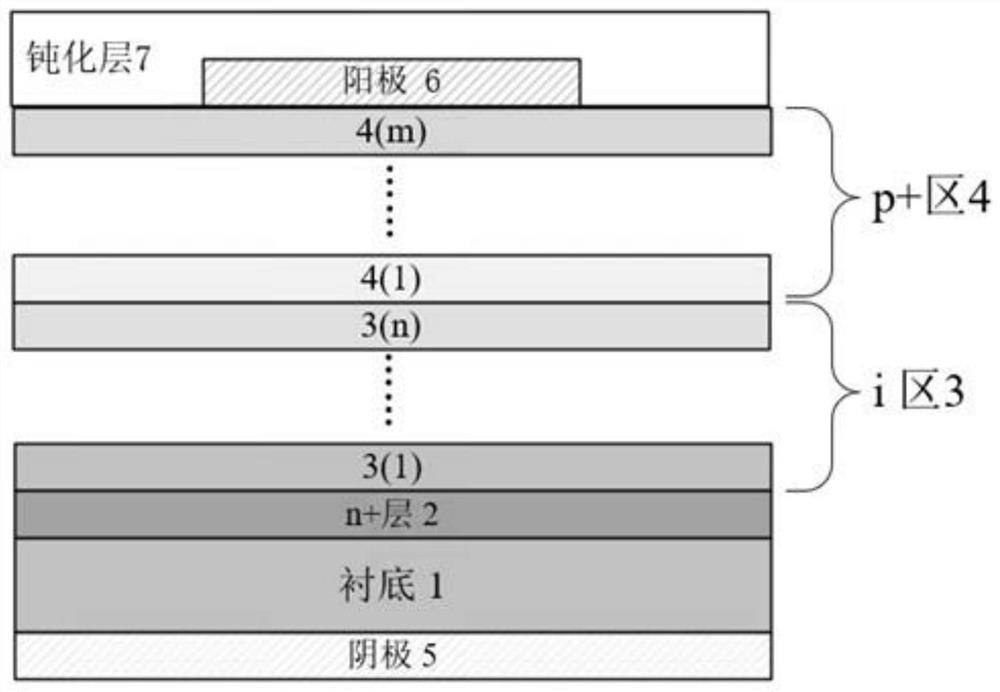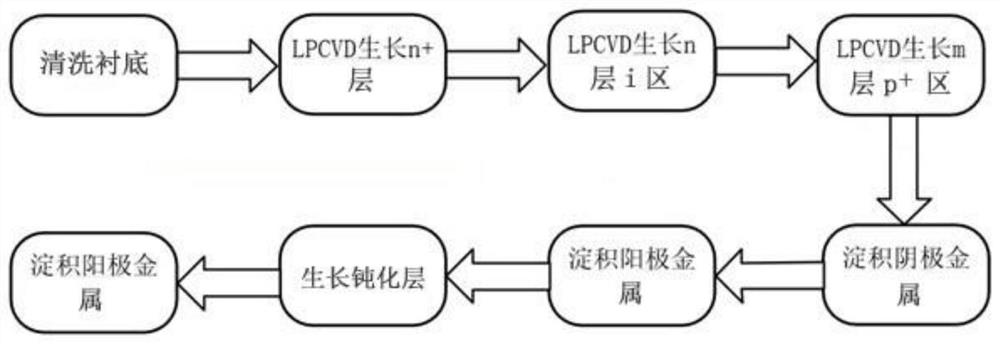4H-SiC PIN microwave diode based on gradient doping of P region and I region and manufacturing method of 4H-SiC PIN microwave diode
A gradient doping, diode technology, applied in semiconductor/solid-state device manufacturing, electrical components, circuits, etc., can solve problems such as being unsuitable for microwave circuits, and achieve improved power characteristics and reliability, low zero-bias junction capacitance, and low conductance. The effect of on-resistance
- Summary
- Abstract
- Description
- Claims
- Application Information
AI Technical Summary
Problems solved by technology
Method used
Image
Examples
Embodiment 1
[0034] Example 1, fabricate a graded doped 4H-SiC PIN diode with a single layer thickness of 2 μm in the i region, a layer number n of 2, a single layer thickness of 0.5 μm in the p+ region, and a layer number m of 2.
[0035] In step 1, the surface of the 4H-SiC substrate is pretreated to eliminate dangling bonds.
[0036] 1.1) Boil the 4H-SiC substrate in trichlorethylene, acetone, and absolute ethanol for 10-15 min in turn, then wash with deionized water and boil for 10 min, and then in H 2 SO 4 :H 3 PO 3 =Heat 10min in the solution of 3:1, put into deionized water to clean then, to eliminate surface dangling bond;
[0037] 1.2) Use 5% HF solution to remove oxides on the surface of the cleaned substrate.
[0038] Step 2, making n+ layers.
[0039] 2.1) Put the pretreated 4H-SiC substrate into a low-pressure chemical vapor deposition LPCVD system, set the reaction chamber pressure to 10 Torr, and the temperature to 1500°C;
[0040] 2.2) Feed into the reaction chamber s...
Embodiment 2
[0056] Example 2, fabricate a gradiently doped 4H-SiC PIN diode with a single layer thickness of 2 μm in the i region, a layer number n of 3, a single layer thickness of the p+ region of 0.5 μm, and a layer number m of 2.
[0057] In step 1, the surface of the 4H-SiC substrate is pretreated to eliminate dangling bonds.
[0058] The specific implementation of this step is the same as step 1 of Embodiment 1.
[0059] Step 2, making n+ layers.
[0060] Put the pretreated 4H-SiC substrate into the low-pressure chemical vapor deposition LPCVD system, set the reaction chamber pressure to 50Torr, and the temperature to 1500°C; Hydrogen at 1500 sccm, C with a flow rate of 20 sccm 2 h 4 and SiH at a flow rate of 10 sccm 4 , grown on a 4H-SiC substrate with a thickness of 0.5 μm and a doping concentration of 10 19 cm -3 4H-SiC n+ layer.
[0061] Step 3, making multi-layer gradiently doped i-regions.
[0062] A N source with a flow rate of 70 μmol / min, a hydrogen gas with a flow ...
Embodiment 3
[0073] Example 3, fabricate a gradiently doped 4H-SiC PIN diode with a single layer thickness of 2 μm in the i region, a layer number n of 4, a single layer thickness of the p+ region of 0.5 μm, and a layer number m of 3.
[0074] In step A, the surface of the 4H-SiC substrate is pretreated to eliminate dangling bonds.
[0075] The specific implementation of this step is the same as step 1 of Embodiment 1.
[0076] Step B, making n+ layers.
[0077] B1) Put the pretreated 4H-SiC substrate into a low-pressure chemical vapor deposition LPCVD system, set the reaction chamber pressure to 100 Torr, and the temperature to 1500°C;
[0078] B2) Feed into the reaction chamber at the same time a N source with a flow rate of 100 μmol / min, a hydrogen gas with a flow rate of 2500 sccm, and a C source with a flow rate of 16 sccm. 2 h 4 and SiH at a flow rate of 8 sccm 4 , grown on a 4H-SiC substrate with a thickness of 1 μm and a doping concentration of 10 20 cm -3 4H-SiC n+ layer.
...
PUM
| Property | Measurement | Unit |
|---|---|---|
| thickness | aaaaa | aaaaa |
| thickness | aaaaa | aaaaa |
| thickness | aaaaa | aaaaa |
Abstract
Description
Claims
Application Information
 Login to View More
Login to View More - R&D
- Intellectual Property
- Life Sciences
- Materials
- Tech Scout
- Unparalleled Data Quality
- Higher Quality Content
- 60% Fewer Hallucinations
Browse by: Latest US Patents, China's latest patents, Technical Efficacy Thesaurus, Application Domain, Technology Topic, Popular Technical Reports.
© 2025 PatSnap. All rights reserved.Legal|Privacy policy|Modern Slavery Act Transparency Statement|Sitemap|About US| Contact US: help@patsnap.com


